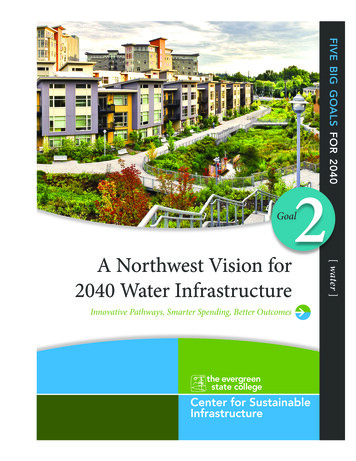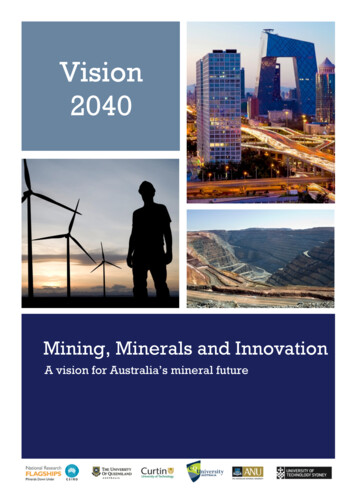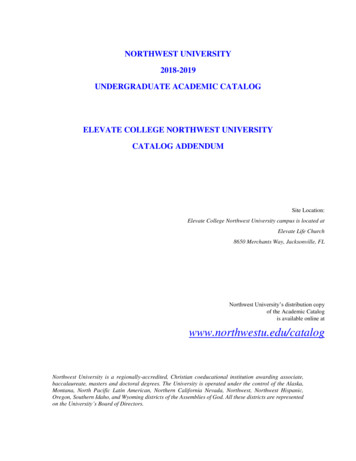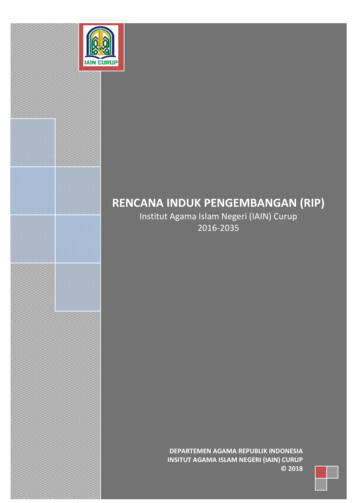
Transcription
FIVE BIG GOALS FOR 20402GoalInnovative Pathways, Smarter Spending, Better Outcomes[ water ]A Northwest Vision for2040 Water Infrastructure
FIVE BIG GOALS FOR 20402GoalWater SupplyWastewaterStormwaterIntegrated Resilient Sustainable AffordableAuthor: Rhys RothDirector, Center for Sustainable Infrastructureat The Evergreen State Collegewww. evergreen.edu/csiCo-Author: Patrick MazzaCover Image: Thornton Place in Seattle, Washington.Thanks to Seattle Public Utilities, Lorig, Era Living, MIG SvRand Walsh Construction. Photographer, Eugene Shibayama.
Table of ContentsIntroduction and Overview. 2The Changing Utility Investment Portfolio. 30The Focus. 2Smart Tech: No Longer Flying Blind. 30Five Big Goals for 2040. 2Green Infrastructure. 31Approach for this Report. 3Coming Soon?: The New Micro-Infrastructure. 33Key Takeaways. 3Turning Wastewater into High Value Resources. 36The Great Challenges Facing Water Utilities. 5Diversifying Local Water Supplies. 38The Social Compact for Utilities. 5Watershed Collaboration. 39The Equity Challenge. 7Protecting Headwaters, Restoring Watersheds. 39Infrastructure Deficit: It’s Both Moneyand Capacity. 9Really Old Systems Need Modernization. 921st Century Solutions Require New Expertise. 11Risk and Resilience. 14Earthquakes. 14Climate Disruption. 15Cities Rethink Stormwater and Flood Prevention. 40Modernizing Irrigation. 42Smart Spending: Checklist for Leadership. 43Top Five Things for Water Utilities to Do. 43Implement the New Investment Discipline. 43Get on a Glide Path to Rate-Based Financing. 44Bridge Silos and Forge Creative Cost-ShareRegulation in Flux. 16Partnerships. 44A Thousand Points of Pollution. 17Commit to Capacity and Innovation. 46A New Model and Investment Discipline Emerging. 19Tap Private Innovation. 46New Model: One Water – Busting Silos toOptimize Value. 19New Investment Discipline and Tools. 21Value Planning: Rethink Spending onTop Five Things for Water Policymakers to Do. 48Align on Principles. 49Set Goals, Get Lean. 49Capital Projects. 22Regulate to Performance, Manage for Outcomes. 51Asset Management 2.0: Transform System-WideSupport Local Capacity Building. 53Planning. 24Pooling Resources for Shared Solutions. 25New Vision: World-Class by 2040. 27The New Investment Portfolio - More Options,More Opportunities. 29The Quick History That Gave Us Today’sWater Infrastructure. 29Strategically Invest in Infrastructure Jobs. 55Conclusion. 57Acknowledgments. 58Sponsors. 60
Center for Sustainable Infrastructure2The Northwest’s Water InfrastructureIntroduction and OverviewThe FocusClean, readily available water is vital for any community to thrive. Local sewage and wastewaterhas to be processed to protect public health.And storm waters need to be managed to prevent local flooding.A Northwest Vision for 2040 Water Infrastructure:Innovative Pathways, Smarter Spending, BetterOutcomes paints a picture of how the PacificNorthwest can develop integrated systems tosupply, purify, and manage water that are amongthe most sustainable and resilient in the world.At the same time, these systems must be affordableand beneficial to the people, today and tomorrow,who will pay for them: rich, middle-class, and lowerincome people alike.In the Northwest, like America as a whole, mostcommunities boast water, wastewater, and stormwater infrastructure that was built last century, andwas world-class when first installed. Those systemsled to revolutionary improvements in public healthand economic growth. But today much of last century’s infrastructure is old, inefficient, prone to breakage, andvulnerable to earthquakes and climate disruptions. Billions ofdollars will be needed to modernize our water infrastructureto serve the people that will live here in 2040.This report serves as a guide to rethink and reboot today’sinfrastructure investment strategies. It is a guide for water,wastewater, and stormwater decision-makers and policymakers and their stakeholders – from their community andindustry partners to, ultimately, the public and customersthey serve. The immediate goal is smarter spending thatachieves performance and cost excellence, and delivers morelong-term community benefit – economic, environmental,and social – for each infrastructure dollar that is spent.Five Big Goals for 2040This report on water is the second in the “Five Big Goalsfor 2040” series, produced by the Center for SustainableInfrastructure (CSI) at The Evergreen State College, toengage top Northwest thought leaders and innovators inmapping the path to achieve a shared and transformative2040 infrastructure vision.Broadly, CSI champions a new infrastructure investmentparadigm by centering on long-range strategic foresight,new decision tools, and integration across systems forbroadly-shared, long-term community value.The fundamental premise of the Five Big Goals series is that,in a world of rapid change and growing challenges, we canCommunities rely on water infrastructure systems to serve some of theirmost vital basic needs, such as providing people an uninterrupted flowof clean drinking water. Other important functions include removal ofwaste and pollutants, and flood prevention.no longer afford to simply replicate old infrastructure investment models. Innovation is required. Decisions made todayhave ramifications that will shape outcomes for decades tocome, and the operating environment in that future will bedifferent than today.The series taps the region’s leading infrastructure thinkersand innovators to broadly reimagine infrastructure systems,synthesizing their insights to provide guidance and inspiration for infrastructure decision-makers. Products are refinedthrough review by high-level teams of experienced leaders.Our framing report, Infrastructure Crisis, SustainableSolutions: Rethinking Our Infrastructure InvestmentStrategies, drawing on interviews with 70 regional thoughtleaders and innovators, came out in late 2014. The reportset “Five Big Goals for 2040” in energy, water, recycling,transportation, and integrated performance, as a conversation starter. To dive much deeper into energy, the first in our“Five Big Goals for 2040” series, Rewiring the Northwest’sEnergy Infrastructure, was issued early in 2016.The aim of this report is to identify investment pathways tobuild world-class 2040 water infrastructure which performsbetter, at the same or lower cost, endures an earthquakeor big storm with greater resilience, leverages innovativetechnology and best practices, and gives our kids a healthier
Center for Sustainable Infrastructure3The Northwest’s Water InfrastructureIntroduction and Overviewenvironment. This is the kind of shared vision for Northwestleadership that Five Big Goals seeks to develop.Approach for this ReportA Northwest Vision for 2040 Water Infrastructure bringstogether three main types of water infrastructure that by2040 could be managed much more holistically, as integrated systems: 1) water supply; 2) wastewater treatment andrecycling; and 3) stormwater and flood prevention.The report is both aspirational and practical, finding pointsof alignment among a broad range of perspectives – the firstattempt to construct a regional shared vision for the futureof water infrastructure in the Northwest.It focuses primarily on leadership by water infrastructureagencies and policymakers, but other players – non-profits,companies, foundations, investors, colleges, customers – areimportant partners in building a high-performance culturethat can develop world-class water infrastructure systems inthe Northwest.2Goaltoward something closer to a shared perspective. That said,the report’s shortcomings, as well as its assertions, remaincompletely the responsibility of its primary author.The findings of the process are presented in four sectionsthat follow:— Great Challenges Facing Water Utilities— A New Model and Investment Discipline Emerging— The New Investment Portfolio: More Choice,More Opportunity— Smarter Spending: Checklist for LeadershipKey TakeawaysBetween now and 2040, the Northwest will spend billionsof dollars year in and year out to maintain, operate andmodernize water, wastewater, and stormwater infrastructure.The multi-billion dollar question for the Northwest: Howdo we generate the most long-term community value fromthese investments?The world of water infrastructure is diverse. This reportfocuses heavily on utility and government infrastructuredecisions because they direct the bulk of the infrastructureinvestment dollar flow. The authors recognize that the bigpicture of water includes important issues outside the scopeof this report, such as state water rights law, competitionbetween water users, infrastructure finance tools, potentialnew federal infrastructure programs, regional water supplyprojections, state and local legal battles of the moment,and countless other important issues. Future versions oradditional work can be done to incorporate innovationsaround these and other issues.For this report, CSI formally interviewed over 40 WestCoast water infrastructure leaders to invite their big picture,holistic insights on the key design question: How canOregon and Washington develop one of the most sustainable, resilient, and affordable water infrastructures in theworld, spanning water supply, wastewater treatment, andstormwater management?Interviewees included utility managers, technical experts,engineering consultants, design innovators, non-profitleaders, tribal officials, and equity advocates. The group’sexpertise spans water supply, wastewater, stormwater, andflood management infrastructures.Perhaps even more importantly, to test an initial synthesisan Executive Review Team of 27 experts and leaders provided detailed feedback on two drafts of this report in late2016 and early 2017. This review was invaluable for groundtruthing the report’s details, identifying important gaps,and significantly reshaping findings and recommendationsA lot of Northwest water infrastructure is old, well past its design life. Ratherthan spending to simply replace the old, the new infrastructure investmentdiscipline first considers alternatives, including innovative approaches toyield financial, social and environmental benefits simultaneously.Our water utilities face a slew of big challenges: from aginginfrastructure built decades ago; to costs to modernize thatare too big for current local utility revenues; to infrastructure vulnerable to costly, even catastrophic, disruption frombig earthquakes and extreme weather; to agency silos thatdiscourage integrated and innovation solutions.At the same time, water agencies are in a time of tremendous change and reinvention. New technologies and systemsare emerging that can expand the solutions portfolio, butalso change the business model for our utilities, while
Center for Sustainable Infrastructure4The Northwest’s Water InfrastructureIntroduction and Overviewopening attractive new opportunities for residents, businesses, and builders. These new systems span all scales –from the building level to neighborhoods and districts, tocity-wide, and to broader watersheds.An emerging industry-wide movement known as “OneWater” is breaking down silos to integrate supply, treatment, and stormwater sectors previously managed separately. And new investment tools are helping innovativewater leaders to plan and spend smarter, both at the projectlevel and system-wide. The prevailing theme is optimizingthe community benefits – financial, social, and environmental – of infrastructure investment.Integrated, multi-benefit projects and programs that bridgeagency silos are key. They open opportunities for cost-sharepartnerships that can deliver each co-funding partner morevalue for their buck. For multi-benefit projects, water utilitiescan pool resources with a wide-range of potential cost-sharepartners, including other water agencies, energy utilities,health providers, carbon investors, transportation andeconomic development agencies, property insurers, socialimpact investors, and fish, wildlife, and parks managers.Putting the pieces together, here’s how world-class waterinfrastructure systems in the Northwest of 2040 will workbetter than today’s: Water management will integrate across traditional silosand optimally blend traditional central facilities withnetworks of micro-infrastructure systems. Utility and government programs will build lean,high-performance cultures that reward innovation andperformance, and value the triple bottom line. Water systems will be infused by smart technologies suchas sensors and cameras that provide real-time informationto achieve efficiencies throughout local systems. Central wastewater treatment plants will becomecommunity economic hubs, producing clean water, cleanenergy, rich soils, and valuable fertilizers. Utilities will develop more collaborative relationships withcustomers and neighborhoods. Utilities will advance their roles in watershed restoration,and forge creative cost-share partnerships for multi-benefit projects and programs. Regional collaboration and consolidation will grow. Smallwater utilities will partner to better meet the challenges. Utilities and governments will focus investment to buildmore resilient infrastructure. Policymakers will couple job creation programs withinfrastructure strategies to grow sustainable jobsthroughout the region.The path to world-class 2040 water infrastructure in theNorthwest has many moving parts. This report boils it downto an action checklist for water utility leaders and for stateand local policymakers. To succeed, though, these leaderswill need to cultivate valuable innovation partnerships withnon-profit agencies, private companies, academic groups,and foundations.The “One Water” paradigm helpsutilities and regulators bridge the gapbetween separate silos and reap thefinancial, social, and environmentalbenefits of designing water infrastructuresystems more holistically. An integratedvision of these systems often uncoversmore affordable, resilient, and sustainablestrategies. For example, utilities investingin water reuse and recycling mustintegrate their water and wastewaterinfrastructure operations.
Center for Sustainable Infrastructure5The Northwest’s Water InfrastructureThe Great Challenges Facing Water Utilities2GoalThis section overviews important challengesthat represent major forces in the operatingenvironment for water infrastructure utilities,forces that they cannot control but to whichthey must respond.The Social Compact for UtilitiesThis report focuses on water, wastewater,and stormwater agencies because they havebeen and will continue to be the chief investors on behalf of their ratepayers. They spendseveral billion dollars each year to develop,manage, and operate infrastructure systemsserving the people and businesses of thePacific Northwest.But water utilities and agencies are in a timeof tremendous change and reinvention. Aswater researcher David Sedlak has proposed,a revolution in water infrastructure is upon us, on the scaleof the ancient Romans’ development of long-range watertransport, and the emergence of drinking water and wastewater treatment in the past two centuries. He calls it Water4.0, with large changes in technology, a move to water recycling and energy recovery, and the spread of distributedsystems. Facing the uncertainties of climate disruption andtechnology change, piling on top of revenue stresses andthe need to replace aging infrastructure, it is hard to conceive of a time of greater challenges for those who manageour vital water infrastructure.A key challenge for utility decision-makers today is thatthe set of tools and technologies to fix and rebuild waterinfrastructure is changing, at the same time that the region’shydrologic patterns of the past 100 years – around whichutilities designed and sized their water infrastructure – nolonger serve as a reliable guide to future Northwest hydrology because of the ways global climate change is disruptingweather patterns.A quick snapshot of the history: Utilities were establishedand granted local monopolies, mostly last century, to supplyessential water services equitably, to all the people and businesses in the community, reliably and affordably. In somecases, it took calamitous events. The Great Seattle Fire of1889, in which 25 square blocks burned down, underscoredthe need for reliable water service and spurred developmentof public water supplies. Public health and safety are important reasons why we have centralized water systems andwhy they will remain relevant even as decentralized supplyoptions emerge.The social compact under which utilities were formed isgrounded in the most basic fact about water: everyone hasMembers of Ashland, Oregon’s Planning Commission tour their localwastewater treatment plant. (Posted to Flickr by Derek Severson (CC BYNC-ND 2.0) legalcode.)to have it. Utilities exist to secure the ready access to cleanwater that is essential to every person’s life (drink, bathe,cook, clean ) and for every business, school, and agency.Water utilities also protect people against infectious diseaseand toxic exposure by managing waste and pollution in ourwater. And they help protect our homes and property fromdestruction by flood or fire.Our water utilities exist to help secure these essentials foreveryone in the community. Publicly-owned utilities areessentially a form of democratic government, formed amongpeople to pursue shared ends that we can pursue bettertogether than alone.Because utilities collect money from all users of water services in their territory with the mission to supply affordableaccess to everyone, it is imperative utility leaders reinvestthese revenues to optimize the community and system-widebenefits over the long-term.But decision making is often opaque, underscoring theneed for utilities to communicate and collaborate with theircommunities. To work properly, these institutions need tobe accountable and responsive to people they serve, theenvironment, and to property rights holders.As well utilities need to change and evolve as technology,and the needs and priorities of people, change. For example, the spread of distributed micro-infrastructure may wellopen new doors for utilities to provide maintenance servicesfor systems that customers may own, and build networks ofcustomer-owned technologies such as cisterns to managewater flows.
Center for Sustainable Infrastructure6The Northwest’s Water InfrastructureThe Great Challenges Facing Water UtilitiesDisruptive Efficiency Meets Aging Utility Business ModelSuccess can sometimes come withunexpected challenges. In the caseof water, conservation success ischallenging the revenue model forwater utilities.“Demand started to change radicallyin 1992,” says Chuck Clarke, ChiefExecutive Officer of Cascade WaterAlliance. “Since ’92, in King Countypopulation is probably up roughly30-35% and actual total water use isdown 30%.”The trend has multiple sources.Washing machines, dishwashers, andshowerheads are substantially morewater-efficient than past models.A trend to urban density is reducingFor decades, population growth in the Seattle region climbed hand-in-hand withtotal water consumption. Then more water-efficient fixtures and appliances kickedlawn watering needs. Usage-basedin. Today, compared to the 1990s, more people are consuming about 30% lessrates provide incentives to conserve.total water. Source: Seattle Public Utilities and Cascade Water Alliance.In many regions, particularly droughtplagued places such as California,active efforts to engage citizens inconservation have significantly cut water consumption.water utilities and a lot of it is crews, maintaining infrastructure sitting in the ground. On the revenue side, it’s“We’ve got a finite resource yet we’re able to use it withalmost all variable (based on consumption), so whenmore and more people and economic development,” saysdemand began going down that created a shortfall.”Jeff Clarke, General Manager of Alderwood Water andWastewater District. “That’s a really positive development.“That raises questions about how water is valued andrates are set. “In the U.S., we’re coming into a repairBut the challenge is declining revenues. “There is a busiand-replacement cycle for infrastructure,” says Michaelness model and rate structure question for utilities,”Mucha, Chief Engineer and Director for the Madisonsays CH2M Vice President, Liz Kelly. “If the rate structureMetropolitan Sewerage District (and former publicis heavily based on consumption and we incentivize lotsworks director in Olympia, Washington). “We undervalueof conservation, that can create a revenue problem forwater, so we haven’t yet figured out how to pay for this.the utility.”Many other countries charge more – they’ve put a valueChuck Clarke says water managers operated under theon water commensurate with what’s needed to supplyassumption “money will continue to roll in and growthclean water.”will keep revenues going up. It’s taken the industry a longThe rise of building-scale water systems broadens thetime to realize that’s not really true and it’s createdchallenge for utilities. “You’ll see technology changessome pretty serious dislocation.”related to capturing water and processing it at theJudi Gladstone, Corporate Policy Director with Seattlehome and building level,” CWA’s Chuck Clarke says.Public Utilities, points out that most of the cost to supply“Technology will be there at a low cost, and that canwater to users is not for the water itself, but for the infracreate significant dislocations for utilities. If you reducestructure to deliver it. Chuck Clarke notes that, “The fixedwater demand (from the utility) by another 30% by 2030,costs for the infrastructure are 80-90%. You think aboutthat’ll have huge consequences for utility balance sheets.”
Center for Sustainable Infrastructure7The Northwest’s Water InfrastructureThe Great Challenges Facing Water UtilitiesThe Equity Challenge Utility leaders must also look for – and invest in rectifying –patterns where businesses, schools, and people in disadvantaged and rural neighborhoods are most exposed to thehazards of breakdowns in our water infrastructure.When floods strike a community, it’s often on bottomlandswhere lower-income people and communities of color tendto live, precisely because the higher risks of such areastranslate into lower real estate values. When lead is discovered leaching from pipes into water supplies, it disproportionately hits children and families in those communities.Witness Flint, Michigan. In 2014 the city switched to watersupplies from the Flint River to reduce costs. But the waterhad corrosive effects on aging lead pipes in the city. Leadleached into the urban water system, elevating levels inchildren’s blood past health standards. High lead exposureattacks the brain and nervous system of children. The crisisresulted in criminal charges against public officials.“Disproportionate impacts are something I think utilitiesare just starting to think about,” says Jennifer Devlin withPortland Bureau of Environmental Services (Portland BES).2Goal“Public infrastructure systems designed to serve communities are affected by the larger context of institutionalracism in the United States, where the systems are setup to serve the rich, with people of color at the bottomless well-served,” adds Anita Yap, Founding Partner ofMultiCultural Collaborative. “You can’t really talk aboutenvironmental issues without talking about equity –understanding the community impact. And you reallyneed to understand the long-standing nature of theequity problems.”Rising water service rates also pose equity challenges.The infrastructure needs documented in this section areforcing many utilities to raise their rates. But this challengespeople with limited budgets, including seniors, disabledand other low-income populations.Says Colin Bailey, Executive Director of the EnvironmentalJustice Coalition for Water, “So many systems of our governance are really challenged to their core by income inequality. Utility costs are climbing and when a significant segmentof the population can no longer afford it, you start to erodethe basic social contract because people can’t access thebasic dignities of life – water and sanitation.”First responders can be paralyzed by earthquakes or flooding in ‘super storm’ events, like this ambulance stranded by Hurricane Sandy in Hoboken,New Jersey. (Posted to Flickr by Alec Perkins (CC BY 2.0) ode.)
Center for Sustainable Infrastructure8The Northwest’s Water InfrastructureThe Great Challenges Facing Water UtilitiesThe Jade District: One Neighborhood’s Lens on a New Infrastructure VisionAs the Northwest’s water infrastructure continues toevolve, how might changes at the industry level impactpeople on the neighborhood level?The Jade District, located in Southeast Portland, canserve as an excellent example. It is one of the mostdiverse neighborhoods in the state of Oregon, a vibrantcommunity that currently serves as a landing spot formany immigrants. The district features amazing cuisine,close-knit communities, and some strong local institutions.However, incomes are lower than average and some keyinfrastructure is lacking, leading to stark economic andhealth disparities.According to latest data, about 47% of residents arepeople of color and 55% are categorized as low income.Fifteen percent live in linguistic isolation. In terms ofthe built environment, the neighborhood is known forincomplete streets and few parks. The U.S. Forest Servicerecommended level of coverage for urban tree canopyis 40% – the Jade neighborhood averages just 21%, withsome areas even less. On the not-so-distant horizon, thethreat of involuntary displacement due to rising propertyvalues looms large, as rents are continuing to increase andPortland’s urban core expands.If the Jade District of 2040 is going to be a healthy, equitable, and sustainable neighborhood, a holistic approach tocommunity development that includes water infrastructurewill be critical over the next two decades.First, the built environment of the neighborhood will lookdifferent. If green infrastructure is prioritized, agenciesand utilities will find ways to integrate more deeply intothe community, investing for co-benefits such as local economic vitality, resilience, carbon savings, recreation, andbeauty. There will be more tree canopy, public parks, andsmall scale water infrastructure sites. Neighborhood residents have been asking for spaces to bring their grandchildren, practice tai chi, or garden. While this is what they areasking for; green infrastructure can help meet these needsand contribute to better water and air, flood control, andpublic health as well.As the neighborhood becomes a more pleasant placeto live, the consequences of this desirability must beaddressed so that current residents are able to stay andenjoy these new benefits. This will require strong publicplanning, deep investment in affordable housing, and afocus on creation of green jobs that are filled by localresidents. Smart infrastructure investment not onlyhelps control rate increases and keep vital water servicesaffordable for residents and local businesses, infrastructurespending translates into good-paying local jobs. Buildingand maintaining new distributed micro-infrastructure, fromconstructed wetlands to cisterns and building-scale treatment systems, will require both construction and maintenance workers. This can benefit economically challengedcommunities if neighborhood residents are the ones fillingthese jobs. As rents continue to rise, so must the incomeof our residents.Disaster preparedness is typically lacking in the mostvulnerable neighborhoods. Smart investment helps vitalwater services resist catastrophic breakage and recovermore quickly when earthquake or climate disaster strikes.However, neighborhood resilience is much more thaninfrastructure. True resilie
are too big for current local utility revenues; to infrastruc-ture vulnerable to costly, even catastrophic, disruption from big earthquakes and extreme weather; to agency silos that discourage integrated and innovation solutions. At the same time, water agencies are in a time of tremen-dous change and reinvention. New technologies and systems










